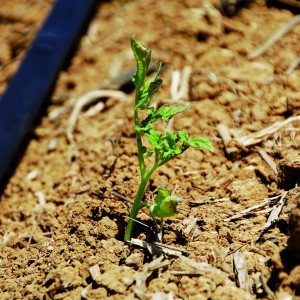Crop rotation means alternating crop variety each season for at least three growing seasons this means that the same crop will not be planted in the same place and will return to it after three growing seasons. It is a necessary practice where tomato is cultivated in monoculture.
 The main reason crop rotation is adopted is to avoid land fatigue, in other words the land needs to rest to recover its nutrients.
The main reason crop rotation is adopted is to avoid land fatigue, in other words the land needs to rest to recover its nutrients.
There are few simple rules that need to be followed. It is not possible to alternate crop variety without taking into consideration certain factors. Excessive exploitation of land resources results in an impoverishment of the land when the same crop is planted in the same place repeatedly; the vegetable will then withdraw all the nutrients and make the land unusable for cultivation. Crop rotation is used to avoid this problem by exploiting the land sustainably. Crop rotation also interrupts the life cycle of pathogens and the risk of damage by diseases. The main rule is never to repeat the same crop in the same plot for more than a growing season. When rotating you need to avoid to plant crops that belong to the same botanic family as they have the same requirements and end up using up the same nutrients. Alternating same family crop will have the same effect as using the same crop. So for tomatoes for example it is not possible to alternate it with a same family crop such as eggplant (aubergine) as they belong to the same family (solaneceae) and have the same type of pests and diseases.
As a start, you want to know to what family group a replacement plant belong to.
Tomatoes and eggplants are known to be great consumers of earth nutrients particularly nitrogen, in this case it would be convenient to use, in the succeeding rotation this plot with plants that do not deplete nutrients such as beans or maize.
Tomatoes can be grown in monoculture or by intercropping. Intercropping means cultivating two different species of plants in proximity. This gives greater turnover in a single plot of land. Two different plants will use the land nutrients at different depths to increase land exploitation.
Allowing the land fallow once a year might seam as a waste but it is the best and most natural way to make the land recover its lost nutrients. The same plot of land can be left to be used for cattle or simply unused. Often fallow land is left for green manure (crops that have been uprooted and stuffed under the soil). These will add nutrients and organic matter to the soil. These type of crops are usually legumes such as clover and are useful as they enrich the earth with nutrients such as Nitrogen. Green manure increases the percentage of organic matter (biomass) in the soil improving water retention and soil compaction. The nutrients that are released from the decaying plants are then made available to the succeeding crop.
Rotation is not new it is an ancient and a widespread practice especially for certain crops such as tomatoes as they require a lot of nitrogen. Crop rotation results in a decrease in the use of chemical nutrients and improved product quality. A sustainable agriculture policy cannot be considered accomplished without the adoption of certain practices such as crop rotation.
